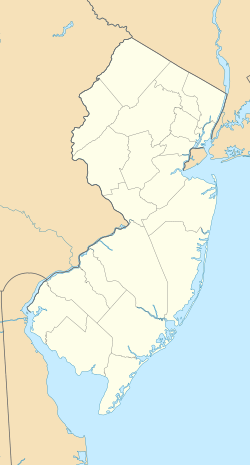Red Bank Battlefield facts for kids
The Red Bank Battlefield is a historic site located along the Delaware River in National Park, New Jersey. This important place was where the Battle of Red Bank happened during the American Revolutionary War. The battle took place on October 22, 1777.
During the war, two forts, Fort Mercer and Fort Mifflin, protected the river. Fort Mercer was on the New Jersey side, and Fort Mifflin was in Pennsylvania. These forts were built to stop the British from using the river to move their ships and supplies. They successfully slowed down the British forces. However, in the end, both forts were either destroyed or left empty.
Today, you can still see parts of the battlefield. There are trenches and cannons that were used by the American soldiers. Only about 100 American soldiers fought against 2000 British and Hessian soldiers here. The Whitall House, an original home from that time, was used as a hospital during the battle. You can visit it today for tours. The battlefield is now part of the Gloucester County Parks system and is called Red Bank Battlefield Park.
Contents
The Historic Whitall House
A main part of Red Bank Battlefield Park is the James and Ann Whitall House. It is located at the end of Hessian Avenue. James Whitall Sr. built this house in 1748. It shows off a classic style of building called Georgian architecture.
This brick and stone house was very close to Fort Mercer. During the battle, it became a hospital for wounded soldiers. The house itself was damaged during the fighting. Ann Cooper Whitall, James's wife, stayed in the house during the battle. She bravely helped care for the wounded, earning her the nickname "Heroine of Red Bank."
Exploring the Park's Features
Even though some of the battlefield has worn away into the Delaware River, parts of Fort Mercer still remain. Fort Mercer was named after Brigadier General Hugh Mercer, who died in another battle. The most noticeable historical feature in the park is the remains of a ditch that once surrounded the fort's earthworks.
Around these old fort areas and along the riverbank, you can see several cannons from that time. Four of these cannons were found in the wrecks of British ships, the HMS Augusta and HMS Merlin. Three American cannons facing the Whitall House were discovered buried on the site in 1935. Near the Whitall House, there is also a preserved section of the chevaux-de-frise. These were sharp wooden spikes placed in the river to stop enemy ships. You can also see various cannonballs found at the battlefield.
Several monuments in the park honor those who fought. There is a memorial for the Hessian leader who died here and was buried on the grounds. There is also a tall monument, about 75 feet high, remembering the battle.
Brave Soldiers: African Americans and Native Americans
The 1st Rhode Island Regiment was a special group of soldiers who fought with the Americans. This regiment was also known by other names, like Varnum's Regiment or the Black Regiment.
This unique regiment included free African Americans, enslaved people, and Native Americans. If an enslaved person fought, their owner would be paid fairly for them after the war ended. Then, the enslaved person would become free.
There is a historical marker at the battlefield. It tells the important story of the African American, enslaved, and Native American soldiers who fought bravely alongside the Americans in the 1st Rhode Island Regiment.
Notable Burials at Red Bank
- Carl von Donop (1732–1777), a Hessian colonel who fought with the British. He died during the battle here.
In June 2022, the remains of 13 Hessian soldiers were found. They were discovered on land bought by Gloucester County in 2020, at the northern end of the park. These remains are currently being studied by the New Jersey State Police forensic lab.
Visiting Red Bank Battlefield Park
The park covers about 44 acres and is open to visitors during daylight hours. The Whitall House has more limited visiting hours, so it's good to check before you go. Every October, there is an annual reenactment of the battle on the park grounds. It's a great way to see history come alive!
See also






